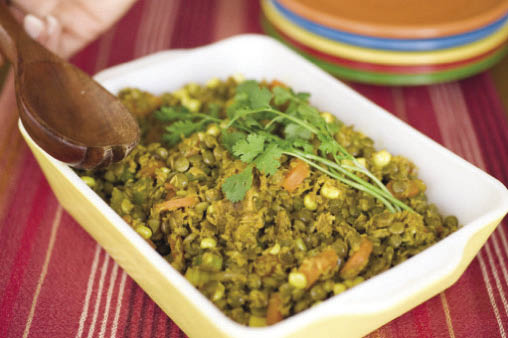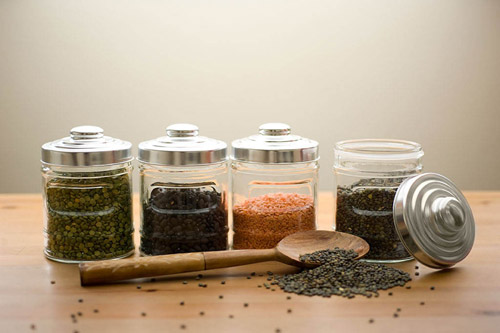Blissful Bites (40 page)

![]()
![]()
![]() ⢠Makes 4 to 6 servings
⢠Makes 4 to 6 servings
A light summertime sea vegetable salad, this adds nutrition to any meal. Or serve with rice crackers as a snack.
1
â
3
cup wakame flakes, soaked three minutes, then drained
2 Persian cucumbers, thinly sliced on the diagonal
1 medium orange, zested and juiced
1 teaspoon maple syrup
2 tablespoons brown rice vinegar
1 tablespoon tamari
1 teaspoon ginger, grated (optional)
Pinch sea salt
1 tablespoon sesame seeds, toasted, for garnish
Combine all ingredients except sesame seeds in a medium bowl and allow to marinate for 15 minutes, stirring occasionally. If it needs more sea salt, season to taste after it marinates. Garnish with sesame seeds and serve.
![]()
![]()
![]() ⢠Makes 2 to 3 servings
⢠Makes 2 to 3 servings
This dish is savory and satisfying and a great way to sneak in sea vegetables. Be sure to use the stalk of the broccoli; just cut off the woody parts before dicing.
1
â
2
cup arame, soaked three minutes, then drained
4 ounces tempeh, cubed
Filtered water
Dash tamari
2 teaspoons sesame oil
1 stalk celery, thinly sliced
1 cup carrots, cut on diagonal
Pinch sea salt
1
â
2
cup asparagus, cut on diagonal
1
1
â
2
cups broccoli, cut into stems and florets and chopped
Dash brown rice vinegar
1 tablespoon stone-ground mustard
Sea salt, to taste
Simmer the arame, tempeh,
1
â
3
cup water, and tamari in a small saucepan for about five to ten minutes, or until all the liquid is absorbed.
Meanwhile, heat oil in medium skillet over medium flame. Sauté celery and carrots for three minutes, cover with lid, and stir occasionally. Add a pinch of salt, asparagus, and broccoli stems and sauté for two more minutes. Add a splash of water if the veggies begin to stick.
Lastly add the broccoli florets and stir in the arame-tempeh mixture, vinegar, mustard, and a dash of water if necessary. Simmer with lid on for three minutes. Taste and season with tamari if needed.
“I do feel that spiritual progress does demand at some stage that we should cease to kill our fellow creatures for the satisfaction of our bodily wants.”
â Mahatma Gandhi

lentil-coconut curry
ââââââââ
The age-old question posed to all vegans is “Where do you get your protein?” And to this I say, you can find protein in almost all foods. Some have more than others, though, with animal foods being the most concentrated source of protein. But our bodies prefer plant-based proteins, like beans, legumes, grains, nuts, and seeds. These proteins are easier to digest, and do not have the saturated fat and cholesterol that lead to blocked arteries. Since they take less energy to digest, they leave us feeling light and energetic. Many studies suggest that we don't need as much protein as we are led to believe. Everyone's needs are different, but I encourage you to replace some animal-centered proteins with vegetable-quality proteins found in this chapter.
                       Â
black-eyed pea bbq stew
fresh corn and zucchini frittata
tempeh reuben with russian dressing
                       Â
curry chicken-less salad
hawaiian tofu and veggie kabobs
tofu salad (eggless egg salad)
                       Â
baked oil-free falafel with tzatziki sauce
blissful two-bean harvest chili
                       Â
azuki beans with squash and chestnuts
pan-fried tofu with carrot-ginger sauce
tofu with almond-coconut cilantro sauce
                       Â
basic beans
Beans are a powerhouse of nutrients, iron, vitamins, and fiber, and free of cholesterol and saturated fat, making them the ideal source of plant-based protein. Below are my favorite beans listed in order of highest protein content along with other protein sources from soy and wheat gluten.
Black and yellow soybeans
Green lentils (do not need soaking)
Le Puy (French lentils, do not need soaking)
Azuki
Cannellini (white beans)
Navy
Turtle (black beans)
Anasazi
Split Peas (do not need soaking)
Garbanzo (chickpeas)
Great Northern
Kidney
Lima
Black-eyed peas
Pinto
Mung beans
Fava
Red lentils (do not need soaking)
Miso
Soy milk, yogurt, cheese
Tempeh
Tofu
Natto
Seitan â “wheat meat”
Making your own beans is a snap if you purchase a pressure cooker. Follow the
basic beans
recipe, on page 202, to make pressure-cooked beans. Many people have a hard time digesting beans. If you follow the steps below, you'll be better equipped to make the best-tasting and most digestible beans you've ever had. I prefer to buy organic beans in the bulk bins at my natural food store.

All beans, legumes, and lentils should be washed to remove any dirt and enzyme inhibitors. Sometimes beans from the bulk bins will have stones or other foreign matter mixed in, so be sure to carefully pick through them while you wash. With the exception of lentils and split peas, I like to soak beans to make them more digestible and save time on cooking. I usually do at least a few hours up to overnight in fresh water. Be sure to drain the soaking water and use new water when ready to cook the beans.
Beans can be cooked in two ways, in a pot on the stove or in a pressure cooker. Small beans and lentils can be boiled on the stove while other dried beans can be cooked in a pressure cooker to save time. Place beans in water in a heavy pot or pressure cooker. How much water you use depends on whether you are cooking in a pot or pressure cooker. In a pressure cooker, you need water just to cover the beans. In a pot you need 3
1
â
2
cups per cup of dried beans. Add a one-inch piece of kombu with the beans to aid in digestion, or put in bay leaves (or both). Kombu also adds many trace minerals and a light flavor to the beans. If using a pressure cooker, follow the manufacturer's instructions. If cooking in a pot, lower the flame and cook until beans are tender (time depends on the bean). With either method, season at the end. Do not put salt in at the beginning.
All canned bean brands at the writing of this book, save for the Eden brand, have BPA in the lining of the aluminum cans, so it's best to avoid canned beans except when in a serious time pinch. BPA stands for Bisphenol A and is a chemical used when making plastic that is harmful to our health. Most of the recipes offer the option of using fresh beans or canned. If you do decide to use canned beans, be sure to drain and wash them thoroughly.
Remember this rule of thumb:
2
â
3
cup of dried beans = about 1
1
â
2
cups; cooked = about 1 (15 ounce) can of beans.
There's quite a bit of controversy about soy products these days. You'll even find many soy-free recipes in this cookbook. Personally, I don't think that fermented and traditional soy products (tempeh, tofu, shoyu, tamari, miso, natto) are “bad,” but anything in excess is not good. So if you are eating a plant-based diet, choose a variety of protein sources for your meals, not just tofu, and then you don't need to worry, unless you have a serious allergy to soy.
Depending on what brand of tofu you buy, it may be best to press the tofu to get out the excess water before starting a recipe. If the tofu is packed in water, you will get better results with pressing. To press tofu, remove from package, wrap tofu in a clean dish towel and place on cutting board. Put a plate or another cutting board on top of tofu, then place a heavy item on top on that. This could be anything that is about 3 pounds and not so heavy that it smashes the tofu (a large book works well). Leave for 10-15 minutes.
Tempeh and tofu should be steamed or cooked for at least 10 to 15 minutes to aid in digestion. Never eat tempeh and tofu raw. One word of adviceâstay away from textured vegetable protein (TVP), analog meat substitutes, and anything that has “soy protein isolates” on the label if possible. TVP is often used in fake meat products. These foods are helpful when you are first transitioning to a plant-based diet, but I wouldn't eat them often. Soy-protein isolate is the stuff people are talking about when they say soy is “bad.”
Even more so than soy, many people have developed an allergy to wheat and gluten, because it's in every processed food you can imagine. Seitan is the protein that's left when you remove all the bran and germ from wheat flour and is a great protein source for vegetarians. Its meat-like texture is very versatile, and allows you to create recipes to please both omnivore and herbivore. I don't use it much in this cookbook, but I do in the most delicious
barbecued seitan
recipe, on page 192, you've ever had!
